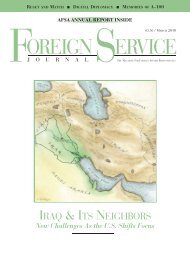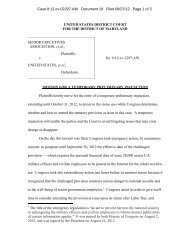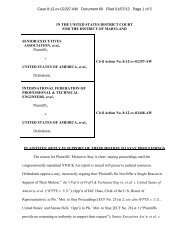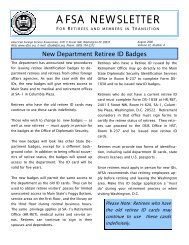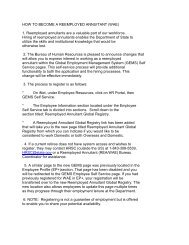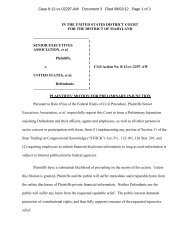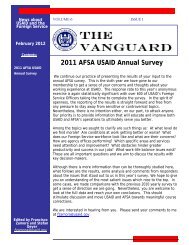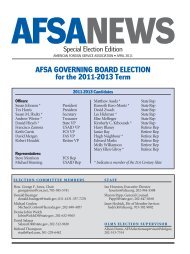F OCUS - American Foreign Service Association
F OCUS - American Foreign Service Association
F OCUS - American Foreign Service Association
You also want an ePaper? Increase the reach of your titles
YUMPU automatically turns print PDFs into web optimized ePapers that Google loves.
development and governance priorities, and monitor the<br />
many U.S.-sponsored development activities in their<br />
province.<br />
Our officers are uniquely effective. Unlike in Iraq —<br />
where the PRTs have large civilian contingents, including<br />
contractors as well as civilians from other agencies — in<br />
Afghanistan personnel from the <strong>Foreign</strong> and Civil <strong>Service</strong><br />
are the only nonmilitary representatives at their PRTs. As<br />
such, they wield great responsibility, often at reasonably<br />
junior ranks. Among the few civilians assigned to remote<br />
Forward Operating Bases, each provides a value far in<br />
excess of what could be expected from one person. In one<br />
case we received information that a particular terrorist<br />
group was so concerned over the impact that one officer<br />
was having that they issued orders to kill the individual (in<br />
response, we took appropriate steps).<br />
Our opponents are right to be afraid. By openly and<br />
persuasively engaging tribal leaders, we are able to convince<br />
them that sending their daughters to school is a<br />
good thing and that it is better that their young men build<br />
roads rather than behead road builders. By their efforts,<br />
our people are at once helping Afghanistan and countering<br />
the insurgency.<br />
While military personnel do engage in these tasks,<br />
they recognize the expertise that civilians bring — and<br />
want more. Last fall, we began examining how to bolster<br />
the civilian presence at our PRTs. Some argued for a<br />
replication of the model that has proven successful in<br />
Iraq, where the PRTs have a robust civilian presence.<br />
This approach was rejected, however, primarily because<br />
PRT bases in Afghanistan are small, so adding extra civilians<br />
would not only increase the logistical burden but<br />
transform a compact, well-running institution into a larger,<br />
less nimble bureaucracy. Additionally, very few of the<br />
Afghanistan PRTs are based at or near major military<br />
facilities. In any case, there simply aren’t the spare bodies<br />
to go around.<br />
“PRT Plus”<br />
Instead, it was decided that the same effect could be<br />
achieved by adding State and USAID personnel to the<br />
embassy and to the brigades that oversee the PRTs.<br />
After some interagency polishing locally, Embassy<br />
Kabul’s “PRT Plus” concept was approved by Washington<br />
and will be funded through a supplemental to be<br />
implemented as soon as funding is available.<br />
In addition to quantity, we also focused on quality<br />
34 FOREIGN SERVICE JOURNAL/JULY-AUGUST 2008<br />
F <strong>OCUS</strong><br />
through changes in focus, planning and training. An<br />
important step occurred earlier this year when the<br />
embassy’s State PRT office was given the interagency<br />
lead for local governance, a key element in our effort to<br />
connect the Afghan people to their government. This<br />
transformed the office from an operational shop into a<br />
policy section. The embassy’s hard-working political section<br />
is primarily focused on issues of national governance.<br />
The PRT section, which directly controls the officers<br />
deployed to the provinces, is able to reach much deeper<br />
into the local level, developing an expertise that is difficult<br />
for a Kabul-based officer to master.<br />
Innovative work is also taking place in terms of our<br />
counterinsurgency effort in Afghanistan. USAID staff<br />
working with U.S. forces are successfully integrating<br />
development interventions into combat planning and<br />
operations, which is helping achieve greater success for<br />
the “clear, hold, build” counterinsurgency strategy in<br />
remote and insecure areas. This has had great success in<br />
mitigating negative reactions following combat operations.<br />
Civilian advisers follow the forces, assisting to<br />
repair damage and implementing quick-impact projects<br />
that make an immediate and measurable difference in<br />
the lives of local residents. Examples include “microhydro”<br />
projects, small hydroelectric facilities that can<br />
bring power to a village for the first time in its history.<br />
Such seemingly small steps can make the difference in<br />
determining whether a village supports the insurgents or<br />
turns toward the government.<br />
We are also making strides in preparing our people for<br />
working closely with the military in a foreign environment.<br />
State’s Office of the Coordinator for Stabilization<br />
and Reconstruction and USAID’s Office of Military<br />
Affairs have broken new ground as they work to refine<br />
the three-week training course for incoming civilian PRT<br />
staff. The course, conducted at Ft. Bragg, brings together<br />
the military and civilian elements of each team.<br />
Additionally, we have focused on promoting continuity,<br />
to ensure that we do not repeat the Vietnam-era syndrome<br />
of fighting a series of “one-year wars.” The first<br />
step was taken when the State PRT offices became interagency<br />
lead for local governance. Our next effort<br />
involved the dispatch of S/CRS teams to each of the U.S.led<br />
PRTs. These teams drew on proven private-sector<br />
strategic planning instruments, already used extensively<br />
by the military services and intelligence community, to<br />
design, test and validate an integrated planning process.



